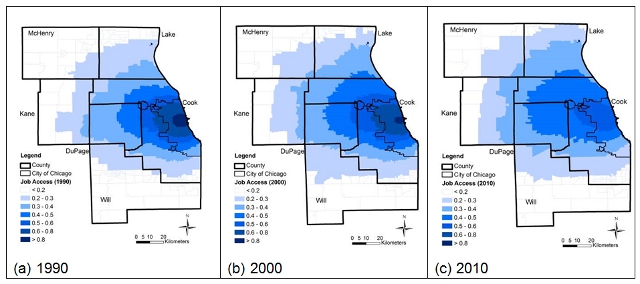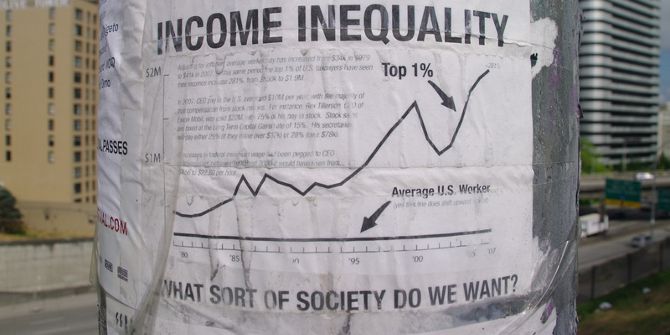 In recent decades, America’s cities have experienced a trend towards the suburbanization of housing and jobs, whilst at the same time, economic restructuring has reduced the number of well-paying low-skilled jobs, and caused rising rates of poverty. But how have these changes affected job opportunities for the poor? Using data from Chicago from 1990 to 2010, Lingqian Hu finds that the suburbanization of poor job seekers and their matching job opportunities has benefited them and improved their job accessibility. At the same time, however, the reductions in the number of relevant jobs and increasing poverty levels have adversely affected poor job seekers, especially in the inner city.
In recent decades, America’s cities have experienced a trend towards the suburbanization of housing and jobs, whilst at the same time, economic restructuring has reduced the number of well-paying low-skilled jobs, and caused rising rates of poverty. But how have these changes affected job opportunities for the poor? Using data from Chicago from 1990 to 2010, Lingqian Hu finds that the suburbanization of poor job seekers and their matching job opportunities has benefited them and improved their job accessibility. At the same time, however, the reductions in the number of relevant jobs and increasing poverty levels have adversely affected poor job seekers, especially in the inner city.
Since the 1940s, two kinds of transformation have significantly affected the employment prospects of the poor in the United States. The first is a spatial redistribution of jobs and housing, and the second is social and economic restructuring in metropolitan areas.
The first transformation is associated with changes in the spatial arrangements of jobs and housing. After World War II, poor minorities in the U.S. had fewer residential choices and were constrained to the inner cities. At the same time, their jobs had become suburbanized, especially those manufacturing jobs that had been traditionally held by low-skilled and low-wage workers. These inner-city residents had limited affordable and efficient transportation options to reach these newly suburbanized jobs. These spatial factors combined result in low job access and unequal labor market outcomes of poor minorities in the inner cities.

The second transformation is the social and economic restructuring that has affected the nature and size of poorer groups and their matching job opportunities. Economic restructuring has shifted jobs from manufacturing to service sectors, and reduced the number of better paying low-skilled jobs. Meanwhile, the population in the United States in poverty increased from 25 million in 1970 to 46 million in 2010, according to Census data. A decreasing number of jobs and an increasing population in poverty have affected the employment prospects of the poor.
While both transformations have affected job access for the poor, most U.S. policies have focused on remedies that address only one of these transformations. For example, the Job Access and Reverse Commute Program and the Moving to Opportunity Program aim to reduce spatial separation, whereas regional economic development programs work to increase the number of job opportunities. Individual programs tend to have limited impacts, but this does not mean that the programs are ineffective. A combination of policies and programs that deal with both spatial and socioeconomic factors might have greater impacts. With this in mind, and using Chicago as a case study, I looked at to what extent spatial and socioeconomic transformations have affected job access for the poor over the past two decades.
Using the numbers of poor job seekers, the number of jobs that are suitable for them, the travel distance among them and their matching job opportunities, I was able to calculate job accessibility scores in each census tract across the Chicago metropolitan area in 1990, 2000, and 2010. The average job accessibility in the whole study area declined, from 0.510 in 1990 to 0.501 in 2000 and to 0.423 in 2010.
Figure 1 – Job Accessibility of the Poor in Chicago, 1990-2010

Figure 1 presents job accessibility scores for Chicago over a twenty year period. Job accessibility forms a peak in the Chicago downtown area and decreases with increasing distance from this peak. Poor job seekers in the inner city still have higher job access than those in the suburbs. Although the concentration of the poor in the inner city leads to intense job competition, the concentration of job opportunities offsets this competition and benefits the poor job seekers residing there.
The changes in the number of poor job seekers and their matching job opportunities, as well as subsequent changes in job accessibility scores, are associated with both socioeconomic transformation and spatial reorganization of jobs and job seekers. Next, using different weighting methods, I separated the effects of these two factors.
Figure 2 – Changes in job accessibility, supply, and demand due to spatial and socioeconomic transformation in Chicago, 2010-2000

Note: Positive changes are shown in pink, and the shading darkens as the change increases. Negative changes are shown in green.
Figure 2(a1) and Figure 2(a2) show changes in job accessibility in Chicago between 2000 and 2010 based solely on spatial transformation and socioeconomic transformation respectively. Figure 2(a1) shows that spatial transformation has increased job accessibility in most places except for downtown Chicago and the surrounding area. In other words, spatial reorganization – the move to the suburbs – reduces the barriers between poor job seekers and their matching job opportunities. Places that are further away from downtown Chicago show greater positive effects. Figure 2(a2) shows that the socioeconomic transformation – rising poverty levels and fewer jobs – has reduced job accessibility for the whole study area, and that the greatest reduction occurred in the central city area of Chicago.
To understand how job accessibility has changed, we need to dissect the two components of the way that job accessibility is measured: job supply (Figure 2(b1) and 2(b2)) and job demand (Figure 2(c1) and 2(c2)). Job supply indicates where job opportunities are located and job demand indicates where poor job seekers reside.
Figures 2(b1) and 2(c1) suggest a trend towards the suburbanization of both poor job seekers and their matching job opportunities: jobs and job seekers have shifted away from the inner city and their numbers have grown in the suburbs. This spatial transformation resulted in the decline of both demand for jobs and job supply in most parts of Cook County and an increase in all suburban counties. The relatively greater decline of job supply due to spatial transformation can largely explain why job accessibility decreased in the central city. Figures 2(b1) and 2(c1) also show that in the suburban counties, both job supply and demand grew, but the magnitude of growth in supply was greater than growth in demand.
Figure 2(b2) and 2(c2) show that looking at Chicago’s socioeconomic transformation, the increase in job demand outweighs that of job supply in the whole study area; thus the area experienced declining job accessibility due to the social and economic transition, with the central city showing the greatest decline. This decline diminishes with increasing distance from the central city.
In general, in the Chicago metropolitan area between 1990 and 2010, spatial transformation—the suburbanization of poor job seekers and their matching job opportunities— has benefited the poor and improved their job accessibility, while socioeconomic restructuring—the reduction in relevant jobs and increases in poverty— has adversely affects poor job seekers.
These results help us to understand the multiple factors that affect job accessibility for the poor. Policies must address both spatial and socioeconomic factors to effectively improve poor job seekers’ employment prospects.
This article is based on ‘Changing Job Access of the Poor: Effects of Spatial and Socioeconomic Transformations in Chicago, 1990–2010’, in Urban Studies.
Please read our comments policy before commenting.
Note: This article gives the views of the authors, and not the position of USApp– American Politics and Policy, nor of the London School of Economics.
Shortened URL for this post: http://bit.ly/1fU06On
_________________________________
About the author
 Lingqian Hu – University of Wisconsin-Milwaukee
Lingqian Hu – University of Wisconsin-Milwaukee
Lingqian Hu is an assistant professor at University of Wisconsin-Milwaukee, School of Architecture and Urban Planning. With many years’ academic training and professional experiences in urban planning, Dr. Hu has accumulated multiple areas of research experience including transportation planning and policy, land use, and urban economics.






